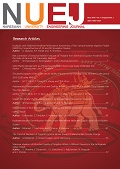Bias Correction of Seasonal Rainfall Forecasts of Thailand from General Circulation Model by Using the Ratio of Gamma CDF Parameter Method
Main Article Content
Abstract
Water management needs rainfall forecasts for planning and responding to flood and drought events. Variation in rainfall can affect water usage activities and reservoir operation. Recently, the seasonal forecasting of rainfall has been conducted based on the relationship between rainfall on a continent and sea surface temperature of an ocean, which then can be used to forecast rainfall patterns for El Nino and La Nina phenomena. General circulation models are an alternative tool that provides seasonal rainfall forecasts. However, their resolution is too coarse to be applied on a river basin and country scale because they employ a mathematical model of the general circulation of planetary atmosphere and ocean to forecast the seasonal rainfall on a global scale. In order to improve the accuracy of rainfall forecasts for both spatial and temporal purposes, the seasonal rainfall forecast data from general circulation models must be downscaled to the station level before they can be utilised in hydrological applications or water planning, This research attempts to develop a new bias correction technique to downscale seasonal rainfall forecasts by using the ratio of gamma CDF parameters with data from three global circulation models including CCM3V, ECHAM4.5, and GFDL. The performance of each bias corrected general circulation model is evaluated by some goodness of fit measures such as root mean square error, mean square error, and sum absolute error. This bias correction method was demonstrated to be able to improve the quality of global circulation model data in both temporal and spatial terms, and CCM3V provides better results compared to other models.

